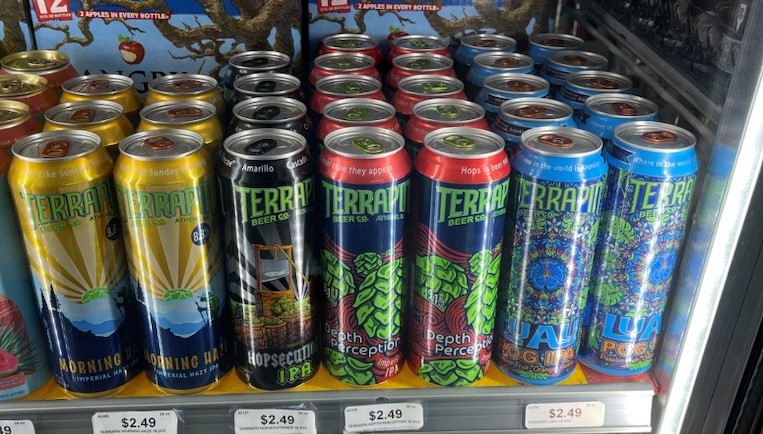Six years ago, you’d be hard pressed to find 19.2-ounce cans in convenience stores. That’s changed in a short time, as the stovepipe has undeniably become the favorite of C-store craft beer consumers grabbing a single, more than likely something hoppy and heavy.
“They really came out of nowhere,” says Matt Herbert, sales director for Tenth & Blake, Molson Coors Beverage Company’s U.S. craft division. “And now they’re everywhere.”
The 19.2-ounce can accounts for more than 92% of craft single sales at C-stores, according to Circana data. Just six years ago, it amounted to less than 10% of craft single sales, while 22-ounce "bomber" bottles owned the channel, with more than 75% of craft single sales. Today, bombers account for less than 1% of craft single sales at C-stores, while 24-ounce cans don’t even clear 7%.
And as more shoppers shift from grocery stores to C-stores, the opportunity to connect with them is growing, Herbert says.
“Convenience shoppers go in knowing what they want and picking up other purchases while they’re in the store,” he says. “When it comes to beer, knowing how exploratory craft consumers are, you have to figure out a way to provide variety, value and trending styles.
“How do you do that? You offer singles.”
The 19.2-ounce “stovepipe” can sits in the middle of that Venn diagram and has continued to attract legal-age drinkers, growing craft sales more than 39% between 2021 and 2022, to $295 million, according to Circana multi-outlet and convenience store data. Isolating convenience store data, the picture becomes even brighter, with 19.2 dollar sales of craft climbing more than 41% to $221 million, representing the lion’s share of sales.
Winning with IPA
And the style that’s winning? IPA, with double and Imperial IPA a particular favorite of consumers.
In fact, three of the top 10 sellers nationally are imperial or double IPA. Tenth & Blake is seeing the same trends with its portfolio. Higher-ABV IPAs are growing, with Terrapin Beer Co.’s Depth Perception Imperial IPA up nearly 383% in 2022 versus 2021 and Hop Valley Brewing’s Alpha Centauri IPA up more than 40%, according to Circana convenience store data.
Terrapin’s 19.2 lineup grew even more last year, with its flagship IPA Hopsecutioner hitting shelves, alongside its Luau Krunkles IPA. Revolver Brewing and A.C. Golden Brewing Co. both released higher-ABV beers in the format this year, as well, introducing their respective All Cattle, No Hat Imperial IPA and Sneaky 8 Juicy Double IPA last month. In Michigan, Atwater Brewery is set to release an imperial IPA soon.
Meanwhile, Hop Valley introduced another imperial IPA, Stash Bandicoot, in 19.2s last year. In total, it has eight beers in 19.2 formats.
“You have this need for flavor and complexity and (19.2s) really fit the bill,” says Adrian Benkonvich, Hop Valley’s president. “And you’re delivering on value. It’s a no brainer for a consumer looking to try something new.
“If you’re curious about trying something new, which one do you think you’re going to pick?” Benkonvich says.
The ultimate goal, of course, is to convince curious consumers to buy larger pack sizes. While 12-packs are typical, Hop Valley recently released its Triple Double imperial IPA variety pack, a six-pack that includes Alpha Centauri, Stash Bandicoot and Cryo Stash, an imperial IPA that was first released as a 19.2 in 2018. Benkonvich is encouraged by the early results.
“Because of the value proposition (of 19.2s), we’re seeing people trial and then jump to a six pack,” he says. “We’re creating a nice little niche for ourselves with six packs.”
Incremental opportunities
The 19.2-ounce offering presents another opportunity to retailers, Herbert says.
“Almost half the consumers that buy a craft beer are also going to buy a premium, premium light, or above-premium lager” he says, citing Circana data. “If you can get the interaction with the consumer that says, ‘I’m going to get a 19.2 and I’m going to pick up a six-pack of Coors Light,’ you’ve just added $9 to your ring.”
In short, incrementality.
And, Herbert says, Molson Coors’ lineup of regional breweries matches up well against national players, like New Belgium, Goose Island and Sierra Nevada, whose roster of 19.2s are surging.
“Only craft can deliver this kind of incrementality.” Herbert says. “It’s easy to sell, it’s profitable and our brands are doing it really well.”


